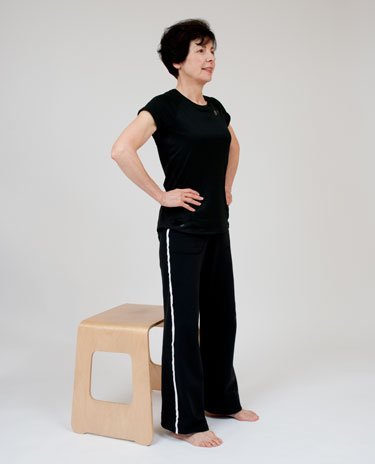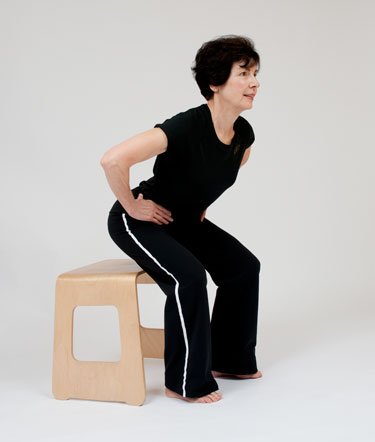Table of Contents
The chair squat is an excellent exercise for older adults.
However, you do not have to be a senior to benefit from the chair squat. For example, if you are recovering from an accident or illness, it is a critical that you build up your strength. The chair squat exercise is a great way to achieve that goal.
This blog will teach you progressive variations so that you build up to the full chair squat exercise. In the first video, I demonstrate a series of modified chair squat exercise variations. If you are new to the chair squat, I suggest you start here.
If you have the strength to get on and off a chair without using your arms and are able to hover above the chair, you will find the instructions and the video demonstration near the bottom of this blog for the chair squat exercise from Exercise for Better Bones.
Alternatives Squat Exercises to the Chair Squat
For some of you who have been hesitant to do a squat due to knee, hip or back pain the wall and ball squat exercise in the Exercise for Better Bones program Beginner level might be a great place to start. If you do not have a ball then the modified chair squats are great alternatives.
Choose the chair squat exercise option that feels comfortable and safe for you.
Let’s cover the benefits of the chair squat and identify any equipment you might need before we get into the exercise demonstrations.
Chair Squats Benefits
The chair squat exercise has many benefits.
First, the chair squat is a functional exercise that helps you do everyday activities — all in a controlled and easy manner. Examples include getting up and down from a chair and getting in and out of a car. The exercise helps you when you need to squat at a public facility toilet, such as a travel stop or airport, without making contact with the seat.
Second, the chair squat exercise targets your upper thighs and buttock muscles, as well as the bones in your hips and spine. This makes it an excellent exercise for people with osteoporosis — in particular those concerned with bone density in the hips. It is also the foundation for doing weighted squats that will allow you to build your spinal muscles and bones.
Equipment
No special equipment is required to do the modified chair squat — all you need is a living room chair with arms. In one of the variations, we use a few pillows, but these are optional.
If you do not have access to a chair with arms, a firm sofa or a sturdy dining room chair will suffice.
How to do Modified Chair Squats
Before we start let’s discuss the best type of chair for chair squats.
Best Chair for Chair Squats
In the video, I use a chair with an arm because it allows a step-wise progression. I recommend this chair type for most people.
If you have to use your arms and hands to help you get up out of a chair, it is a sign that the chair is too low, or too deep or that you are too far back in the chair. I recommend that you try to use a chair that is not too deep-set.
Getting Up From a Chair
Regardless of the type of chair, the first move is to shift your butt forward and sit on the outer half of the seat.
- Next, place your stronger leg behind you.
- Place your hands on the arms of the chair. (One hand on your thigh is an option from a sofa, with the other on the arm of the sofa.)
- Take a breath in.
- Keep your back straight.
- Bend forward from your hips. (Your back will still be straight but on a diagonal.)
- You need to bring shoulders forward over your knees to successfully get up.
- Initially you may not be comfortable with this position, especially if you’re recovering from a fall or an injury. However, this is the correct position, so keep your confidence!
- When practicing, you can place a kitchen chair just inches from your knees with the seat facing you. This will allow you to build confidence to lean forward.
- Once your shoulders are over your knees, push your hands into the arms of the chair and your feet into the floor.
- Keep pushing the floor away from you until you stand straight and tall.
- Finish with your shoulders in a straight line over your hips and knees.
Modified Chair Squat
If you find that getting up from a chair takes effort, I recommend starting with an easier version of the modified chair squat. This next version will help you build up the strength to maintain your independence and ability to get out of any chair.
In the video, I demonstrate this modified chair squat. Instead of lowering yourself to the seat (as you did in the first modified chair squat), you will lower yourself to the top of the chair arm. You’ll be pleasantly surprised how much easier this is.
Instructions
- If you do not feel stable, I encourage you to place the back of a kitchen chair in front of you — just to be on the safe side.
- Stand with your back to the arm of the chair and your feet hip width apart.
- Stretch the space between your feet and knees.
- As you start to sit, think about getting your buttocks back first, before you start bending your knees.
- Keep your chest and gaze up as you lower your buttocks towards the arm of the chair.
- When you feel the arm of the chair beneath your buttocks, push the floor away from you to bring yourself up tall.
Avoid shortcuts. Try to go all the way down and up.
I encourage you to squeeze your butt to get the full benefit of the full range of motion of the chair squat.
These little interim steps are very important. They allow you to build the confidence to go part the way down and hover over the seat when you realize that you need to get back up to attend to something.
Modified Chair Squat Progression
When it is easy for you to get up and down from the arm, it is time to progress to a modified seated chair squat.
This time take one, two, or even three pillows and place them on the chair seat. Over time, you will gradually reduce the pillows until you are able to do the full depth of the chair.
In the video I demonstrate this chair squat progression using pillows.
- If you need the support, reach back so that you have the stability of the arms.
- When you feel the pillow, push the floor away from you to bring yourself up tall.
- If you need to take a rest and sit on the cushion, then by all means, do so.
One way to work on your strength is to avoid sitting down. This is sometimes referred to as hovering. Imagine you’re using a public toilet that you would rather not sit on.
Follow these steps and you will build the strength and the confidence to get in and out of a chair with full control.
Remember to keep your feet hip-width or even staggered so that you have a stable wide base of support.
Knee Position During Chair Squat
Knee position is very important when you do the chair squat. In the video, you can see how at the lowest point in the squat, my knees point in the same direction as my second toe.
As a result, when I get in and out of the chair, my knees do not collapse towards one another. When your knees collapse towards one another the muscles in your hips are less efficient in supporting you and more stress is placed on the inside of your knee joints.
Unfortunately, some of my older clients have built up this habit of collapsing their knees.
For some women it was how they were encouraged to sit down. It was considered more “ladylike” to bring your knees together when going up and down. Unfortunately, this is a great disservice to the muscles in your pelvis and those deep muscles that connect to the hip. These muscles play a critical role in keeping you stable.
Knees and Feet Position
Another thing to think about when you do the chair squat is where your knees are relative to your feet. Think about this space as a positive space that you want to keep open.
Gently stretch the space between your knees as you come up so that the knees point in the direction of the feet, whether you’re going up or coming down.
Take Your Time and Build Strength Gradually
I know that’s a lot to absorb for something as simple as getting in and out of a chair.
However, if you approach the chair squat one height at a time, and one cushion at a time, then I’m confident that you will build strength.
No Chair? Use the End of the Sofa.
If you do not have a small chair with arms, use one end of their sofa.
What works really well is to take one sofa cushion and stack it on top of the actual cushion that you sit on (the big cushion that comes built into the sofa. They are usually four to six inches high and are solid.)
Exercise Recommendations for Osteoporosis
Exercise is an essential ingredient to bone health. If you have osteoporosis, therapeutic exercise needs to be part of your osteoporosis treatment program.
But what exercises should you do and which ones should you avoid? What exercises build bone and which ones reduce your chance of a fracture? Is Yoga good for your bones? Who should you trust when it comes to exercises for osteoporosis?
A great resource on exercise and osteoporosis is my free, seven day email course called Exercise Recommendations for Osteoporosis. After you provide your email address, you will receive seven consecutive online educational videos on bone health — one lesson each day. You can look at the videos at anytime and as often as you like.

I cover important topics related to osteoporosis exercise including:
- Can exercise reverse osteoporosis?
- Stop the stoop — how to avoid kyphosis and rounded shoulders.
- Key components of an osteoporosis exercise program.
- Key principles of bone building.
- Exercises you should avoid if you have osteoporosis.
- Yoga and osteoporosis — should you practice yoga if you have osteoporosis?
- Core strength and osteoporosis — why is core strength important if you have osteoporosis?
Enter your email address and I will start you on this free course. I do not SPAM or share your email address (or any information) with third parties. You can unsubscribe from my mail list at any time.
The Chair Squats Exercise
The chair squat is a strength exercise in Exercise for Better Bones Active level program.
Follow the directions below. These will not only ensure you keep your hips and knees happy for years to come, but that you will have the right foundation to continue to build on.
If this is too difficult, I encourage you to move back to the Beginner Level level, Wall and Ball Squat.
Hand Placement
As you come up from the chair, place hands on your hips or across your chest — whichever is more comfortable for you. Too often people want to push with their hands on their thighs.

Instructions
- From a standing position with your feet hip width apart, gently stretch the space between your feet and your knees.
- Become aware of your weight distribution in your feet as you take a relaxed breath in.
- Start exhaling as you focus on getting your butt back behind you.
- Lower yourself, as you keep stretching the space between your knees and feet. Your knees should be as wide as your feet at the point that your buttocks touches the chair.
- The two images below illustrate the chair squat exercise movement.

Exercise Recommendations for Osteoporosis
Exercise is an essential ingredient to bone health. If you have osteoporosis, therapeutic exercise needs to be part of your osteoporosis treatment program.
But what exercises should you do and which ones should you avoid? What exercises build bone and which ones reduce your chance of a fracture? Is Yoga good for your bones? Who should you trust when it comes to exercises for osteoporosis?
A great resource on exercise and osteoporosis is my free, seven day email course called Exercise Recommendations for Osteoporosis. After you provide your email address, you will receive seven consecutive online educational videos on bone health — one lesson each day. You can look at the videos at anytime and as often as you like.

I cover important topics related to osteoporosis exercise including:
- Can exercise reverse osteoporosis?
- Stop the stoop — how to avoid kyphosis and rounded shoulders.
- Key components of an osteoporosis exercise program.
- Key principles of bone building.
- Exercises you should avoid if you have osteoporosis.
- Yoga and osteoporosis — should you practice yoga if you have osteoporosis?
- Core strength and osteoporosis — why is core strength important if you have osteoporosis?
Enter your email address and I will start you on this free course. I do not SPAM or share your email address (or any information) with third parties. You can unsubscribe from my mail list at any time.
Safe Chair Squats
If you are concerned about your bone health and osteoporosis, follow my guidelines on Safe Squat if You Have Osteoporosis.
Osteoporosis Exercise Plan
Visit my Osteoporosis Exercise Plan page for more information on this topic.

Comments